LED strips are all the rage in the lighting world. They are efficient, affordable and versatile bringing to bear variety in lighting. LED strip lights are flexible circuit boards with light-emitting diodes (LEDs) and other electronic components attached to the circuit board surface. They come in various lengths, colours, and designs and are usually self-adhesive. Depending on your needs, they can be placed on walls, hidden beneath cupboards, or even wrapped around furniture to create personalized lighting. LED strips, which come in a variety of colours, brightness levels, and sizes, can be used to change any space, from offices to outdoor patios, from modern kitchens to comfortable living rooms.

What is a LED Strip
LED strips being a flexible PCB (Printed Circuit Board) are usually cut-able every so often – typically every 5 or 10 cm. The cutting points also do offer a solder surface for interconnection. The number of chips per meter of led strip is referred to as the density of the strip. A 120D LED strip has 120 LED chips per M, if the cuts are every 5cm, then you’d have 6 LED chips between cut lines. LED density has a measurable effect on the quality of light – higher density means a more even light, lower density looks pixellated. However, higher density LED strips have higher power requirements and consequently, higher heat dissipation requirements.
The actual LED chip is a marvel of modern engineering and comes in a wide variety of options. LED chips can be surface mounted (SMD) or surface printed (COB). The common LED chips are:
- SMD 2835 – the most common and newest chip on LED strips. The chip measures 3.5mm x 2.8mm and It’s typically found on strips wider than 5MM. The chips can be found in various white colours from warm white to cool white. Strips can come in a single white colour (Fixed CCT) or tunable colour (warm white to cool white). They are the most recent evolution of LED chips and are more efficient and the brightest per watt. They typically emit about 110 lumens per watt. Density can be pushed up to 240 chips per meter. Higher density results in less visible spotting but with higher electricity usage and light produced.
- SMD 5050 – is the most versatile LED chip. The chip measures 5mm x 5mm and is typically mounted on 10mm or larger LED strips. It is about 25% less efficient on light output compared to 2835 chips, however, it is the goto chip for RGB and addressable requirements. One main disadvantage of SMD 5050 is the low density – typically 60L/M – which results in visible spots/dots in the light emitted. Various chips are offered in the 5050 form factor
- 5050 RGB – offering Red Green Blue on the same chip
- 5050 CCT – offering tunable white.
- 5050 RGBW/C – offering Red Green Blue and choice of either warm white or cool white on the same chip.
- 5050 RGBCCT – offering Red Green Blue and tunable white on the same chip.
- 5050 Addressable – Offering running lights – each chip can be turned on/off individually
- and many more!
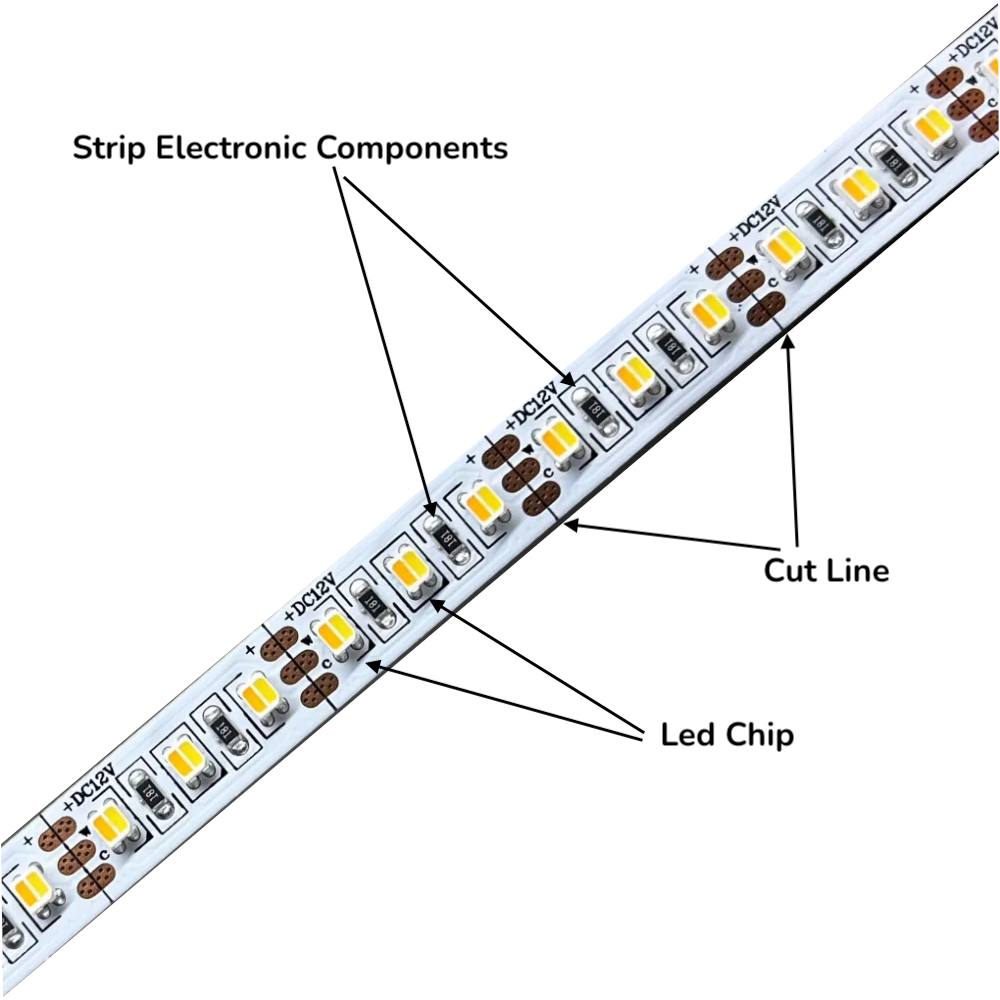
- COB – 320 – 800 – Chip on Board is new LED strip technology where the LED chips are printed/integrated directly on the PCB(strip) as opposed to surface mounting (SMD). A coating is the apply to diffuse the light as well as regulate the colour. COB strips are typically one colour and start at 8MM width – smaller special purpose widths can be found in the wild. Densities for COB vary between 300 and 800 LED chips per meter.
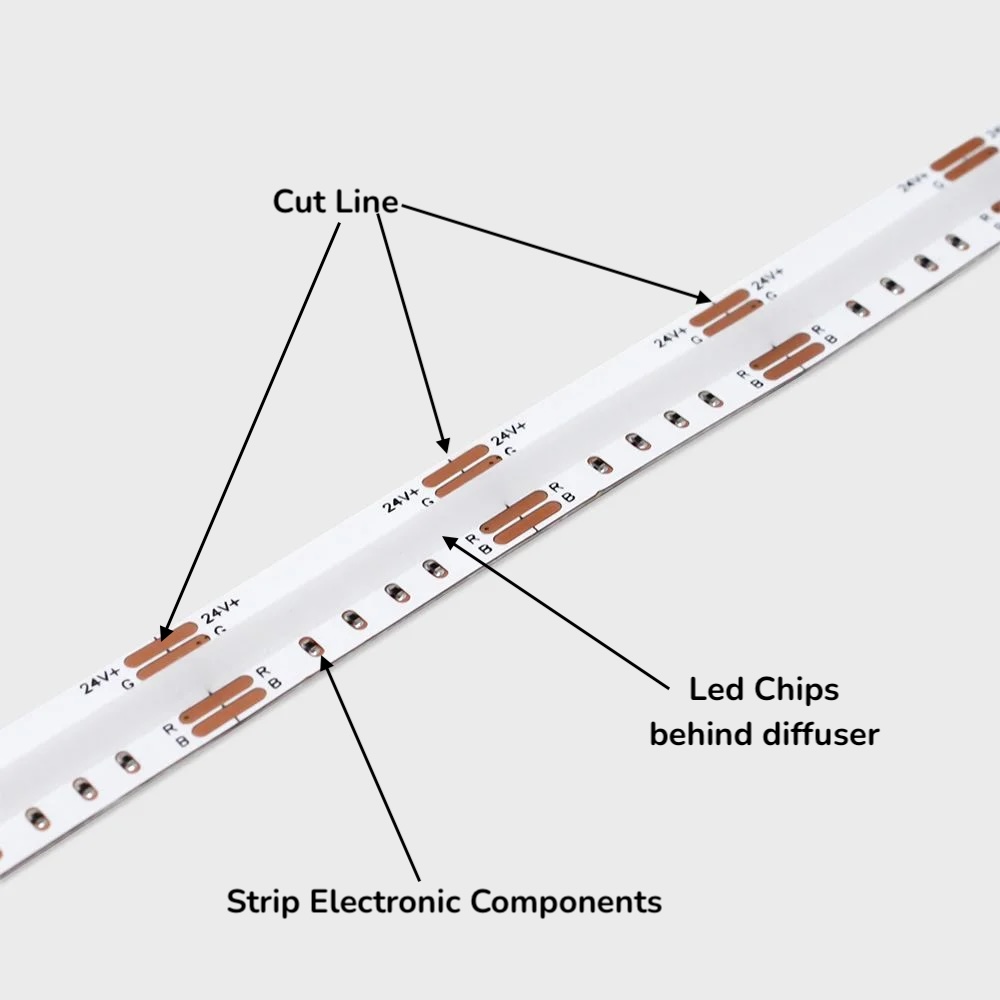
The other important attributes to look at when choosing a LED strip are:
- CRI – A measure of the quality of light produced by the LED strip.
- Low CRI (<80) will make objects appear differently when compared to sunlight (a red apple may appear orange).
- Opt for CRI > 80 for residential and commercial use. For commercial use, opt for as high a CRI as you can afford (typically >90)
- Voltage – LED strips are available in a variety of voltages from 5V to 24V. The led chip primarily influences the voltage involved.
- 5V – Common and multipurpose. Good for short runs due to voltage drop issues (uneven light is produced across the strip). Due to the low voltage, long runs may involve large currents which is always a risk. Typically found in many addressable LED strips.
- 12V – Common and multipurpose. Good for medium runs due to voltage drop issues (uneven light is produced across the strip). Typically found in many addressable LED strips.
- 24V – Recent and multipurpose. Good for long runs and large scale applications. Due to higher voltage, it requires 5 times less current (amps) for the same wattage compared to 5V strips. It also suffers the least amount of voltage drop.
- IP rating – IP rating indicates the resistance of the LED strip to water and dust.
- IP20 – are very common for home use. Perfect for surfaces with no water and no condensation. Cheaper than any other IP rating
- IP65 – Resistant to low pressure jets of water from all direction. The led strip is typically coated with silicon to protect the circuitry. Good for outdoor use where occasional water might hit the surface of the strip such as verandas
- IP67 – Resistant to pressure jets of water and can be immersed. Good for outdoor staircases, wrapping around trees.
- IP68 – Maximum water ingress protection. Can be immersed and used in ponds, swimming pools, building exteriors and any surface.
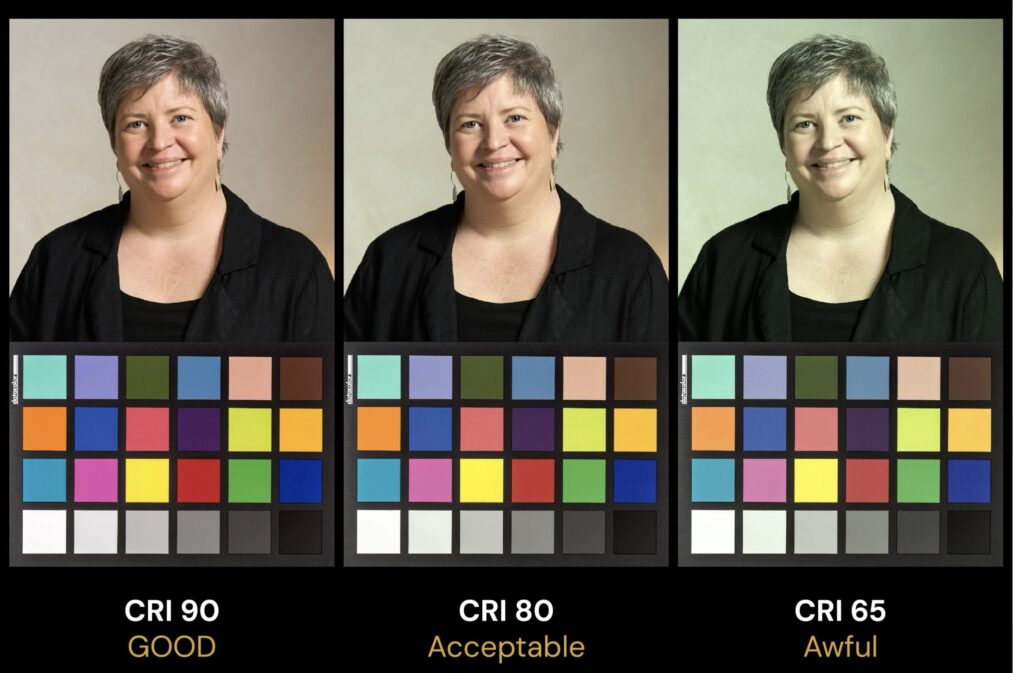
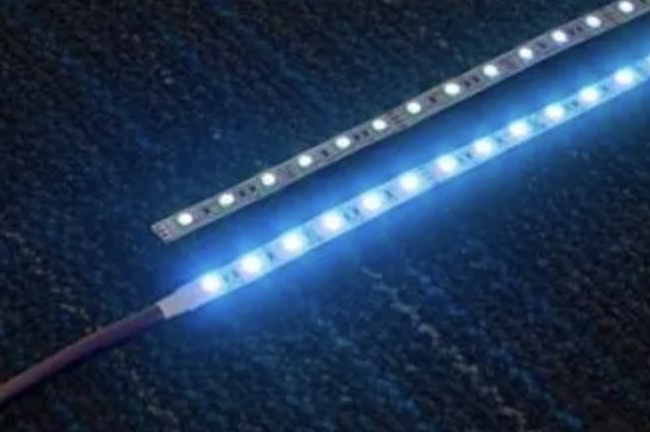
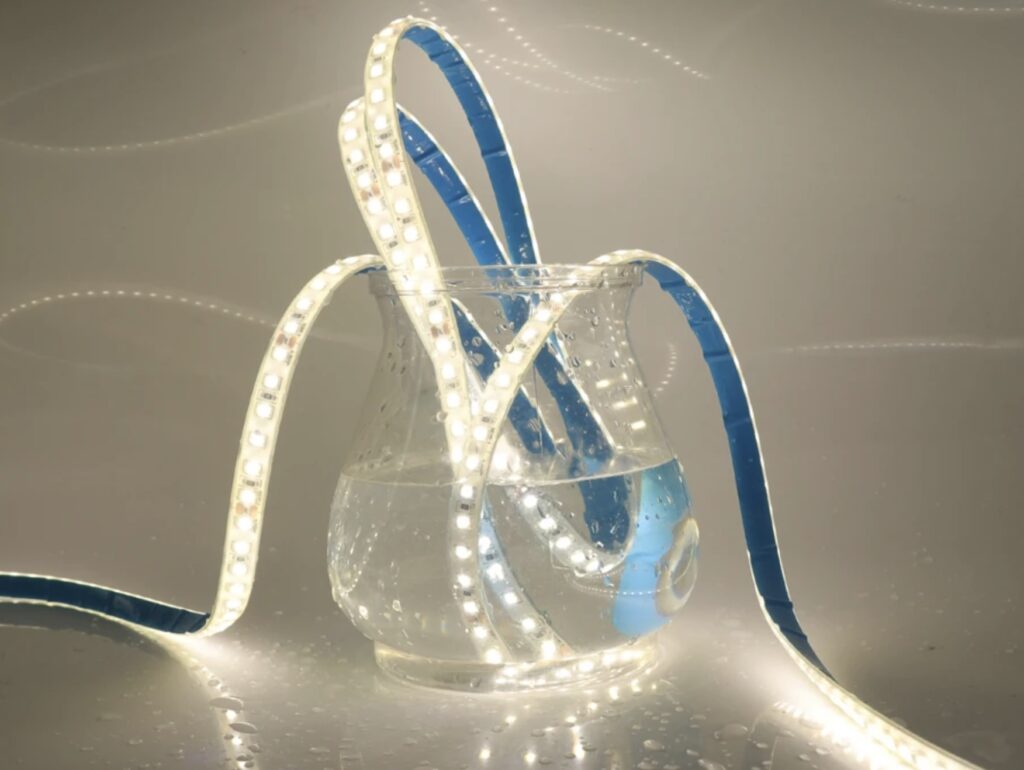
Types of LED Strips.
RGB strip lights
RGB strip lights can produce a wide range of colours by mixing the three primary colors of light—Red, Green, and Blue—using different combinations and intensities. This allows them to create a variety of colours , making them popular for decorative and dynamic lighting applications. They are popular since they allow you select lighting that better fit the mood and atmosphere. They have a long life—often 50,000 hours or more.
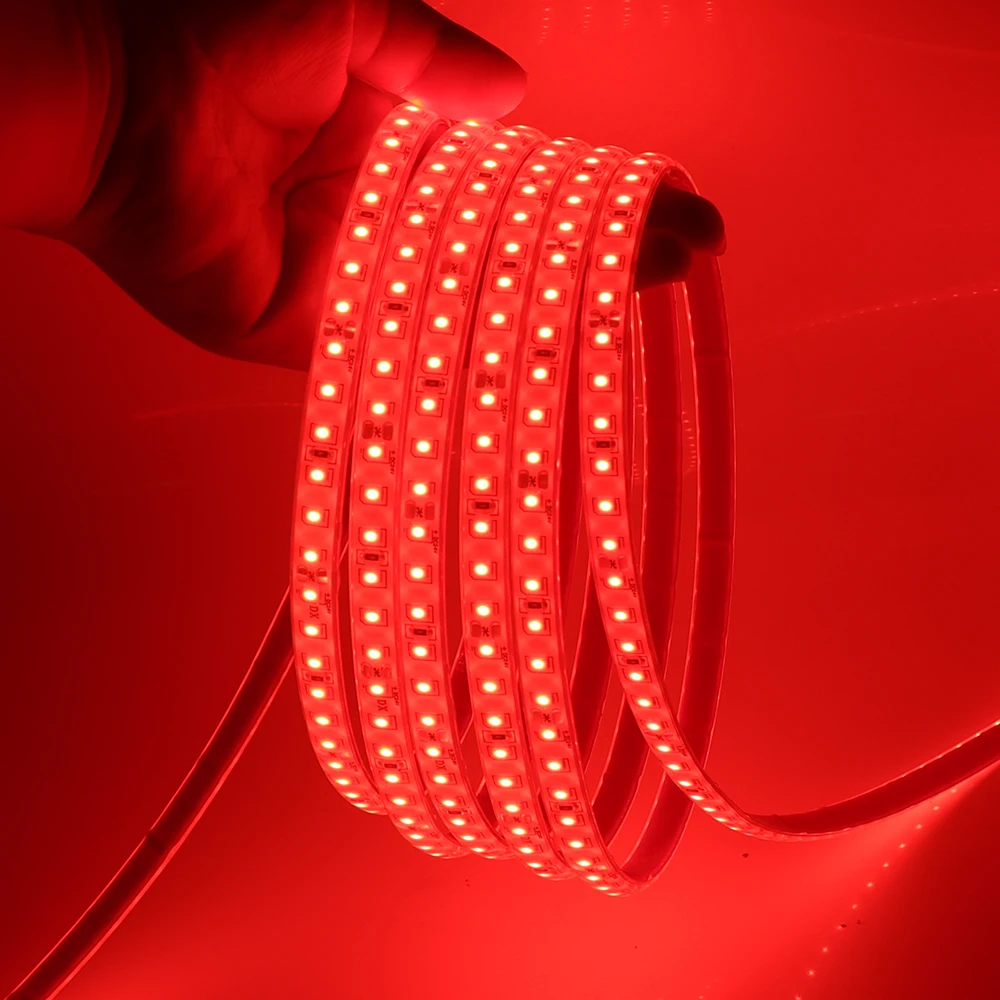

However, setting up and managing advanced RGBs, especially addressable ones (such as WS2812B or SK6812), can be challenging. To achieve certain effects, you may need extra parts like controllers, power supplies, or adapters, which can be difficult for beginners. High-density RGBs—which have more LEDs per meter may overheat, especially when they are not properly ventilated. Heat buildup in these situations may harm the adhesive backing or shorten LEDs’ lifespan. RGB strips can produce a wide range of colours, but often they may affect the quality of pure white light. For example, to synthesise a white light, RGB strips mix red, green, and blue LEDs, however the white light produced will not be as good as conventional white strips. To fix this, RGB strip designers decided to integrate a dedicated white chip! Enter the RGBW or RGBC strip.
RGBC & RCBW Strip Lights
Red, Green, Blue, and White LED strips are referred to as RGBC or RGBW. These are similar to RGB strips, however they have a white LED added specifically for it. In addition to the wide range of colours that RGB LEDs can produce, this additional white LED enables RGBW strips to produce white light that is more realistic and natural. They are perfect for both colourful effects and excellent white lighting. The choice of white chip is set at manufacturing into a warm or cool white one. By utilising the dedicated white light chip, these strips are more energy-efficient than plain RGB strips when creating a white light. RGBWs have more LED chips and are often more expensive.
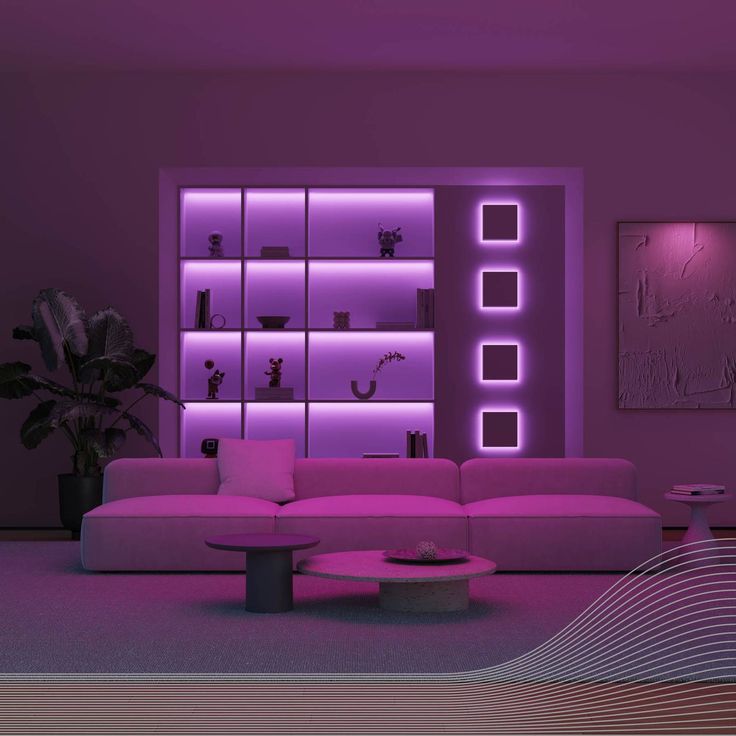
The next evolution on RGBW or RGBC strips is to combine the C and W chips and have the strip as RGBCW – also known as RGBCCT.
More dynamic and complex lighting effects are available with addressable LED strips since each LED on the strip may be controlled independently. With addressable strips, you can build patterns, animations, and colour effects that can change across the strip, giving you considerably more creative control over your lighting design than with traditional LED strips (such RGB or RGBW strips), which control the colour and brightness of the entire strip at once.
RGB + CCT LED Strips
The capabilities of RGB (Red, Green, and Blue) LEDs and CCT (Correlated Colour Temperature) are combined in RGB + CCT LED strips. These strips are made to provide both full-colour (RGB) lighting and the option to change the white light’s colour temperature (CCT). They are very adaptable because of this mix, offering both dynamic colour effects and white light that can be adjusted to produce warm or cool tones.
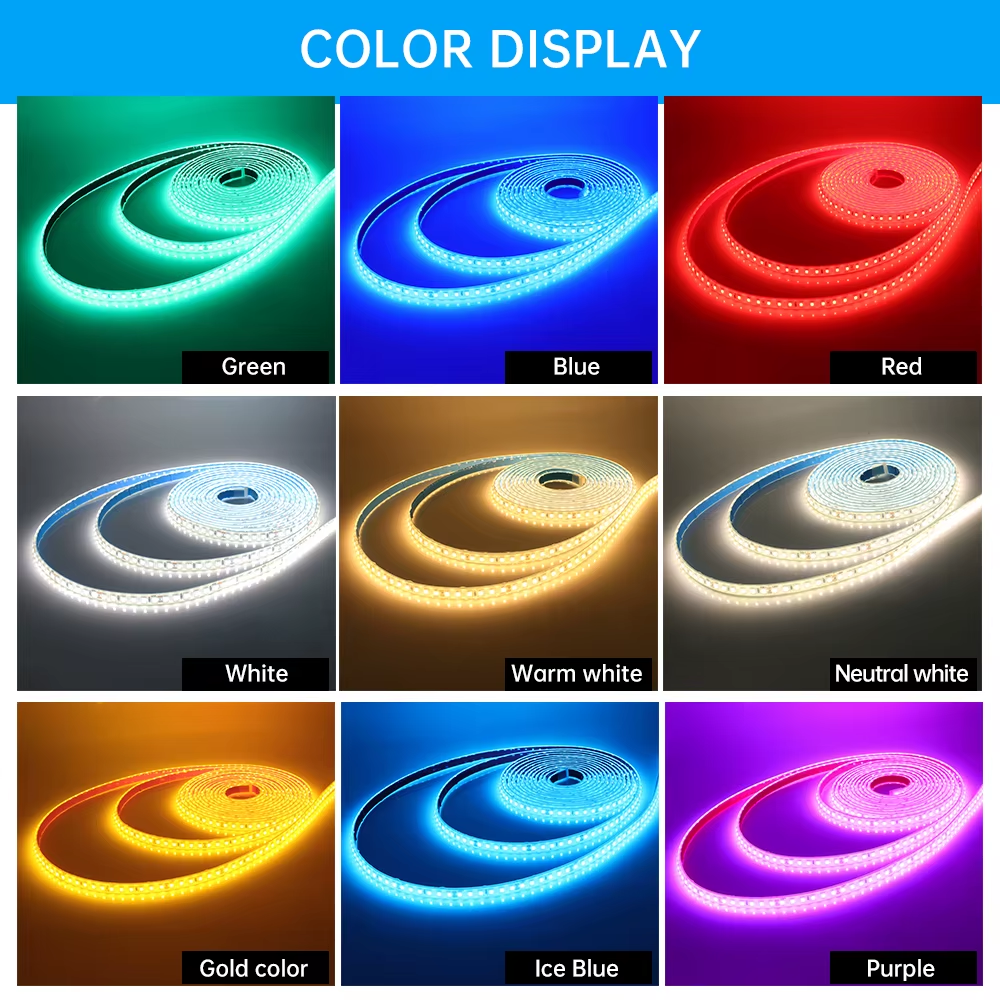
Addressable LED Strips.
Addressable LED chips allow you to control each chip individually. The chip can be turned on or off, dimming can be achieved per chip and in certain cases, variable color patters produced. They typically have a control chip per LED chip or group of LED chips (the grouping is a pixel). A variety of ICs exists that have advantages and disadvantages such as the WS2812, WS2812B, WS2813, WS2814, WS2815 and many more. They require advanced controllers to control each chip. Addressables are capable of creating intricate lighting effects that are impossible with traditional RGB strips. Effects like rainbows, running lights, fire effects, flashing, and more. They can also be synced to sound and music – with the colors or effects changing in time with the beats or rhythm. Because of this, they are perfect for lighting parties, concerts, clubs, and gaming settings where you want the lighting to change in real time in response to the music.
However, they can be more difficult to program and operate than traditional LED strips. To take advantage of the unique control over each LED, you may need to have some programming, electrical, and microcontroller knowledge. They are also more expensive due to the extra circuitry required.
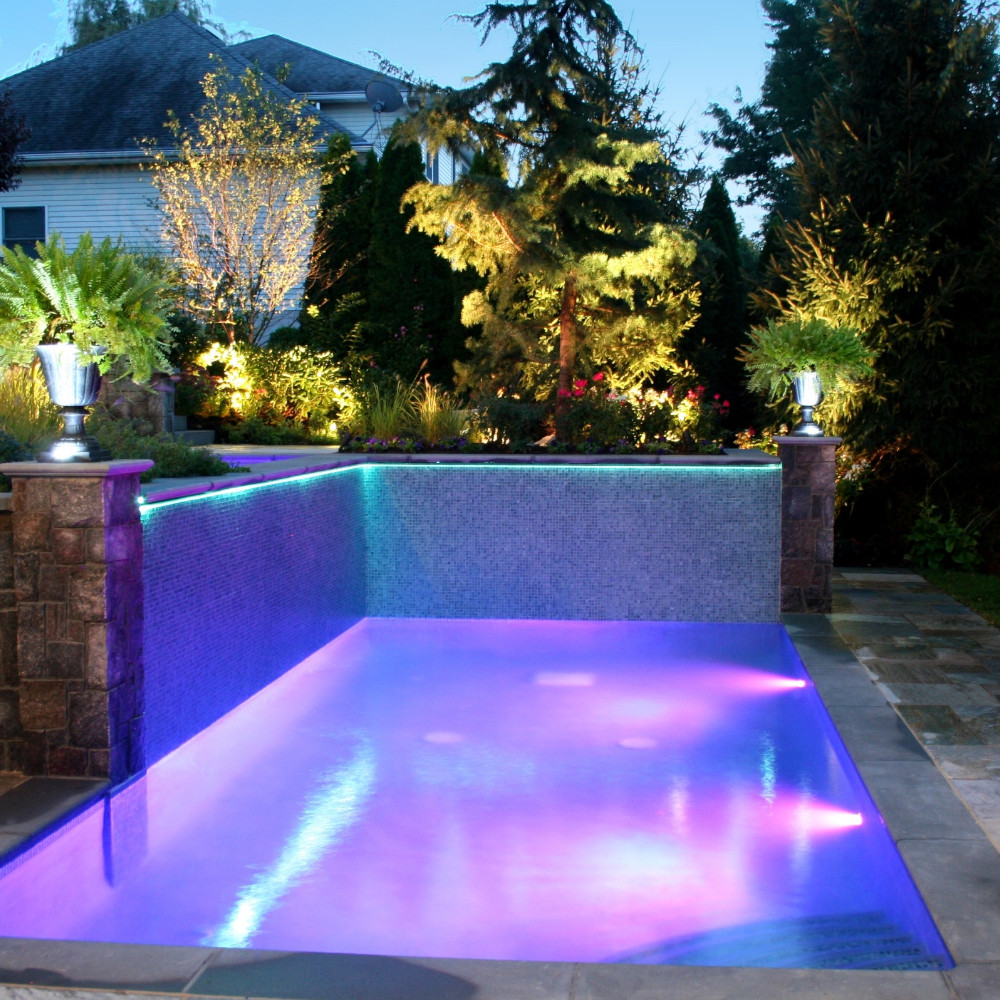
Pros of Addressable LED Strips
- Addressable’s are capable of creating intricate lighting effects that are impossible with traditional RGB strips. Effects like rainbows, running lights, fire effects, flashing, and more can be easily achieved by programming individual LEDs to behave differently.
- Most addressables can be synced to sound and music, with the colors or effects changing in time with the beats or rhythm. Because of this, they are perfect for lighting parties, concerts, clubs, and gaming settings where you want the lighting to change in real time in response to the music.
- Perfect for exhibitions, signage, art projects, and even commercial settings requiring unique, moving light effects. They can be utilized in architectural lighting, LED curtains, or video walls.
- Because addressables may be cut to any length—usually between LEDs—you can create the lighting arrangement that best fits your project.
- Addressables are energy-efficient, using less electricity than traditional lighting yet maintaining great brightness, just like ordinary LED strips.
- With the correct controller, you may improve your setup to control thousands of individual LEDs over numerous strips, and addressables can be connected in series to cover bigger surfaces.
Cons of Addressable LED Strips
- Addressables x.
- Because each LED has its own integrated control chip, it is more expensive than standard RGB strips
- Although being energy-efficient, addressables can use more power than regular strips, especially when using complex animations or running many LEDs at maximum brightness. To ensure reliable operation over longer strips, additional power supply can be required.
- A greater heat output might occur from high-density LED combinations or longer strips. For massive or high-performance setups, proper ventilation or heat dissipation (such as fans or heat sinks) may be necessary.
- Since controllers can only handle a certain number of LEDs, you might need to buy more specialized or powerful controllers for larger setups.
Waterproof LED Strips
Specially made to be water-resistant, waterproof LED strips are ideal for use in areas where exposure to water or high humidity is common. To ensure their durability and performance even in wet conditions, these strips are covered with a protective layer or coating. In bathrooms, kitchens, outdoor lighting, and other places where moisture can be an issue, waterproof LED strips are often used.
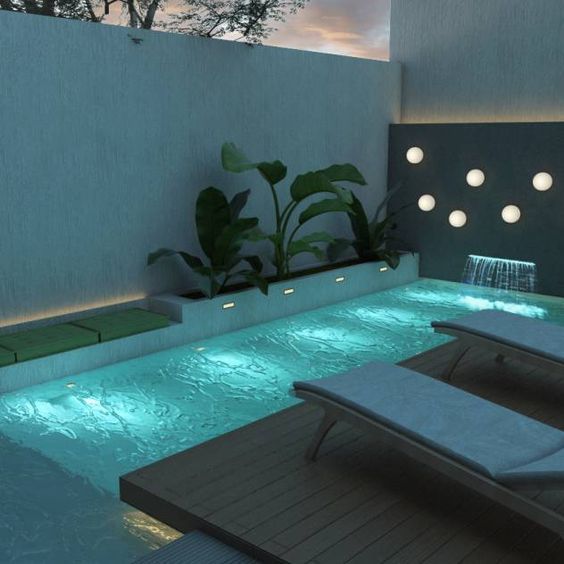
Types of Waterproof LED Strips:
IP Ratings: Waterproof LEDs are classified by their IP (Ingress Protection) rating, which indicates how well the strip is protected from dust and water. The first digit of the IP rating indicates protection against solids (dust), while the second digit refers to protection against liquids (water). A higher number means better protection. The most common IP ratings for waterproof LED strips are:
IP65 Waterproof LED Lights
- LED lights with an IP65 rating are able to resist water jets coming from any angle, but they are not completely waterproof. They provide protection against dust entry and are ideal for uses outdoors, including patios, gardens, and bathrooms.
IP67 Waterproof LED Lights
- IP67-rated LED lights are completely dust-tight and can endure 30 minutes of immersion in water up to 1 meter (3.3 feet) without causing any damage. Submersible LED lights and those used in harsh outdoor settings often have this level of waterproofing. Typically, they are used in marine applications, outdoor garden lighting, ponds and fountains, and decorative lighting.
IP68 Waterproof LED Lights
- The highest possible level of waterproofing is provided by IP68-rated LED lights, which can survive continuous immersion in water for up to several meters (depending on the manufacturer) and offer complete safety against dust. These are made to withstand harsh outdoor environments. Their main applications include maritime lighting, underwater LED lights in marine situations, and underwater lighting for large pools, fountains, and aquariums.
IP54 Waterproof LED Lights
- LEDs with an IP54 rating are able to endure water splashes from any direction and are only slightly affected by dust. Since this grade is lower than IP65, the lights are not suitable for immersion or heavy rainfall, but they can withstand light exposure to water. Porches, balconies, outdoor hallways, and covered spaces exposed to splashes or mild wetness are the usual areas for their use.
IP44 Waterproof LED Lights
- LED lights with an IP44 rating are resistant to water splashes from all directions and offer protection against solid items larger than 1 mm, such as wires. Lights used for bathrooms or enclosed outdoor areas frequently have this rating. Bathroom lighting, porch lighting, outdoor wall lighting, and eaves of houses where the lights are partially protected from heavy rainfall are the typical use for them.
Encapsulated or Coated Strips: Waterproof LED strips are often made with a protective coating or housing to protect the internal components from moisture. There are several methods used to waterproof LED strips:
- Silicone Coating: The strip is covered in a silicone layer that seals it from moisture, making it flexible and resistant to harsh conditions. This coating is ideal for flexible LED strips used in outdoor or marine environments.
- PVC Coating: A PVC (polyvinyl chloride) coating is another common method for making LED strips waterproof. PVC coatings are typically used for rigid LED strips or those used in applications where flexibility is less important.
- Epoxy Resin: Some waterproof strips use epoxy resin to fully encase the LEDs, providing a highly durable, water-resistant layer that can withstand long-term exposure to water.
Pros of Waterproof LED Strips
- For high-moisture or outdoors, waterproof LED strips are suitable. Waterproof LED strips ensure your lights will continue to work even in areas with high humidity or exposure to water, whether you’re using them for task lighting in a bathroom or kitchen or for decorative lighting around a pool.
- Most strips with IP67 or IP68 categories are suitable for underwater uses, including fountains or pool lighting.
- Most waterproof LED strips have connectors for easy chaining, allowing users to improve their lighting setup without the need for complex wiring.
- Waterproof LED strips come in a variety of colors (RGB, white, warm white, etc.), they can be used for a range of uses, including task lighting as well as accent or decorative lighting.
- Many waterproof LED strips may be addressed, allowing colour changes, animations, and dynamic lighting effects.
- Waterproof LED strips, like all LED lighting, use less energy and power than traditional incandescent or fluorescent lights. They are therefore an economical lighting solution for spaces that need constant light.
Cons of Waterproof LED Strips
- Most waterproof LED strips are flexible, although some coatings (such as resin or PVC) may reduce the strip’s flexibility compared to standard non-waterproof strips. If you must connect the strips around sharp corners or in places where flexibility is essential, you might want to take this into consideration.
- Since more protective materials are needed, waterproof LED strips are typically more expensive than standard, non-waterproof ones. If you want use the strips in a dry, indoor setting, the extra cost might not be required.
- Waterproof coatings, especially resin or silicone, may slightly impede heat dissipation, especially if the strips are high-power or used in enclosed spaces. This can lead to the LEDs running hotter, potentially reducing the lifespan or performance. Proper ventilation is important in such installations.
- To completely protect the strip, it could occasionally be necessary to make sure that the wiring and connectors are waterproof as well. If not, moisture could still have an effect on the power supply or connectors, leading to malfunctions.
Conclusion.
LED strips’ flexibility, efficiency, and variety have completely changed modern lighting. LED strips are a flexible and cost-effective way to enhance task lighting, attract focus on architectural information and environment. They are perfect for both home and commercial uses because of their ability to adjust to almost any space and features like color-changing, dimming, and smart controls.
In addition to offering aesthetic appeal, LED strips also help with cost savings and sustainability because of their extended lifespan, low energy usage, and wide range of available designs. LED strips will continue to be the preferred choice for producing customized lighting experiences that satisfy both practical and aesthetic aims as the need for intelligent and flexible lighting grows..
Knowing the basics of LED strips and how to use them well can result in unique lighting solutions that change any place, whether you’re a professional wanting to improve a room or a do-it-yourself enthusiast.
FAQ.
1.Can LED strips be cut to size?
Yes. Most LED strips can really be cut to size. Typically, they have cut points that are clearly indicated so that the circuit can be safely cut without causing damage to the remaining portion of the strip. This makes it simple to change the strip length to suit a particular project or area.
2.Can LED strips be dimmed?
Yes, although many LED strips can be dimmed, you must make sure you’re using a dimmable power source or a dimming controller. Most LED strips are made to be operated by remote controls or software, allowing users to change the brightness.
3.What is the difference between 12V and 24V LED strips?
The operating voltage is the main difference:
12V LED strips are often used in homes. They are more common and simpler to find, but they are usually little less bright than 24V strips.
Since they lose less voltage over long distances, 24V LED strips are usually brighter and better suited for longer light lines (more than 5 meters).
4.What is the lifespan of LED strips?
The average lifespan of an LED strip is between 30,000 and 50,000 hours. Compared with traditional incandescent or fluorescent lights, this is far longer. A number of factors, including quality, heat management, and usage, affect how long the strips last.
5.Can LED strips be used outdoors?
Yes, but only in the circumstances that they have an outside rating. LED strips with an IP65 or higher rating are waterproof and weather-resistant, making them perfect for outdoor use in damp, dusty, or rainy environments. These can be used to attract your attention to architectural features or in patios and gardens.
I am interested, What next?
Give us a call on +254 752 03 03 03, email us using contact@incredible.co.ke or use our contact form to start on your incredible journey to a stellar lighting system. We typically respond within 24 hours. We have wholesale prices and accounts for resellers available on request. We have the in-house expertise to help you design, purchase and execute your project with confidence. We have executed a variety of LED projects across East Africa. You are in good hands.
We offer a variety of LED Strips for both indoors and outdoors while being efficient and affordable.



